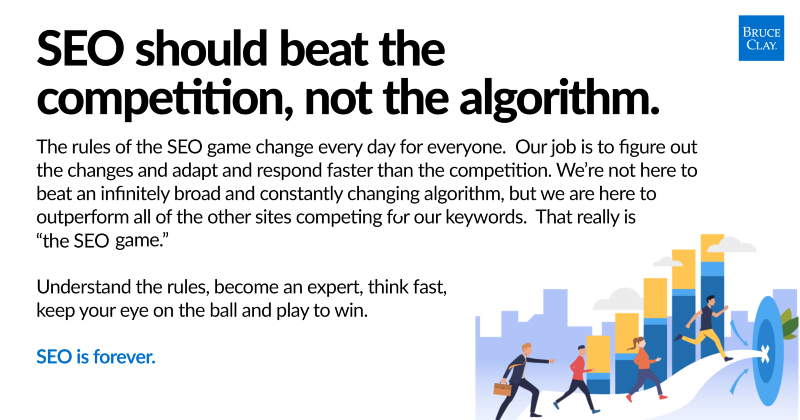SEO Should Beat the Competition, Not the Algorithm
Sometimes in life, you only have to be the least imperfect to survive.
Take, for example, the story of two friends on a camping trip. They get to the campsite and set up their tents in the same manner. Then, they both store their food safely away from wildlife in the same bin. Later on, they eat the same soup dinner, cooked the same way in the same pots.
Then, suddenly, an aggressive bear comes into camp. They start to run. This is where it really matters that they do things differently. Neither of them is Olympic material by any means, but only one has to outrun the other to survive.
This story is not unlike competing to survive online. You don’t have to be an Olympic SEO contender; you have to be the least imperfect to compete in the search results.
- Why ‘least imperfect’
- Sizing up the competition
- SEO celebrates imperfection
- FAQ: Why is SEO imperfection strategy more effective than striving for perfection?

Why ‘Least Imperfect’?
The goal of SEO should never be to beat an infinitely large algorithm. Not only do we have to contend with an algorithm that has hundreds of signals on its own, but we also have to deal with the fact that each searched keyword has a different intent, and that intent biases the algorithm.
Since every keyword has its intent and, thus, its own algorithm, there are as many algorithms as there are keywords. Add to that the bias of RankBrain and an individual’s web history on a query, and truly, multiple algorithms exist for each search.
It is virtually impossible for an SEO professional who doesn’t know exactly what’s in the algorithm to figure out the algorithm. So, instead of beating the algorithm, we need to beat the competition. And the way to do that is to be least imperfect compared to the competition.
Have no fear of perfection—you’ll never reach it.
–Famed surrealist artist Salvador Dalí
Every website is imperfect against the Google algorithm. When Google evaluates which pages to serve in its search results, it chooses the least imperfect compared to others for that search.
For example, say you have two webpages on the same topic from different websites. They both have compelling metadata, quality content written at a similar grade level, image optimization, and structured data markup.
Except one of them has a slower load time than the other. Which webpage do you think is going to win in the search results?
So, it is our belief that it is easier and more manageable to focus not on the algorithm but on the things your competition is doing. And then outdo them through quality SEO strategies.
Sizing Up the Competition
There are a great many ways to assess one webpage or website against another. Of course, the first thing we need to know is which webpages are ranking for our keyword terms. That’s our competition.
And then we need to dissect them. Just some of the things we look at when it comes to dissecting the competition include:
- On-page factors
- Off-page factors
- Technical factors
- Quality factors
Essentially, what is it that’s helping them to rank so well?
Now, a lot of this takes the right tools, but it also takes the right expertise. When you’re analyzing your competition by keyword, you’re not always going to follow best practices prescribed by tools or industry research.
Let’s go back to the bear example. Say you once heard that “playing dead” is better than running from a bear. But that advice only works for protecting yourself against a mother Grizzly bear who is defending her cubs, not other bears or other situations.
Focus not on the algorithm, but on the things your competition is doing. And then outdo them.
A prescribed SEO recommendation based on research across millions of keywords may say, for example, that the optimal meta title is eight words. However, upon further analysis of the search results for your keyword set, you might find the top-ranked pages to be very different.
Tools and data can prescribe recommendations, but they cannot replace expertise. This is key when examining the competition and outdoing them to be least imperfect.
SEO Celebrates Imperfection
We don’t need to know the entire algorithm and its hundreds of variables. What we do need to know is what the competition is up to. Maybe they’re doing five things well, so it’s our job to do those five things better plus one or two more things excellently.
At the end of the day, the webpage that is least imperfect compared to the competition is going to win the race to survive in the search results.
If you found this post helpful, please share it and subscribe to our blog. For help with your SEO strategy, give us a call or fill out our contact form. We’d be happy to talk with you about your business needs.
FAQ: Why is SEO imperfection strategy more effective than striving for perfection?
Search Engine Optimization can be arduous and time-consuming, with diminishing returns over time. Though it may seem counterintuitive, accepting imperfections in an SEO plan may increase website traffic.
- Understanding the SEO Imperfection Paradigm
In the traditional approach to SEO, the focus has been on perfecting every element of a website, from optimizing meta tags to achieving a flawless 100/100 score on performance tools. However, search engine algorithms are not static; they constantly evolve. SEO imperfection acknowledges that perfection is elusive and that over-optimization can backfire.
- The Perils of Chasing Perfection
Striving for perfection in SEO can lead to keyword stuffing, unnatural link building, and other practices that Google penalizes. In contrast, embracing imperfection encourages marketers to focus on creating high-quality content that resonates with the audience, even if it doesn’t adhere to every technical SEO guideline.
- Agility and Adaptability
One of the key advantages of an imperfection strategy is agility. SEO imperfection allows businesses to adapt quickly to algorithm changes and shifting user behavior. Instead of investing extensive resources in overhauling a perfectly optimized website, you can pivot your strategy and content more efficiently.
- User-Centric Approach
SEO imperfection places a strong emphasis on user experience. This approach prioritizes engaging content, intuitive navigation, and mobile-friendliness. By focusing on what users want, you can create a more meaningful connection with your audience, leading to higher rankings and better conversions.
- The Role of Data and Analytics
SEO imperfection doesn’t mean abandoning data-driven decision-making. It encourages a more balanced use of data and a willingness to experiment. By regularly analyzing the performance of your imperfect strategies, you can fine-tune your approach for better results.
Embracing imperfection in your SEO strategy allows you to adapt, prioritize user experience, and achieve more sustainable and effective results. In the dynamic realm of SEO, flexibility and user-centricity are your greatest allies.
Step-by-Step Procedure for Implementing an SEO Imperfection Strategy:
- Assess Your Current SEO Efforts: Evaluate your existing SEO practices and identify areas where you may be over-optimizing or striving for perfection.
- Shift Focus to User Experience: Redirect your efforts towards improving user experience on your website, including mobile responsiveness, site speed, and intuitive navigation.
- Keyword Research: Conduct thorough keyword research to identify valuable, relevant keywords for your niche.
- Content Creation: Develop high-quality, engaging content that addresses user needs and incorporates the identified keywords naturally.
- Link Building: Build organic, high-quality backlinks through guest posting, outreach, and content partnerships.
- Monitor Algorithm Updates: Stay informed about search engine algorithm changes and adapt your strategy accordingly.
- Data Analysis: Regularly analyze website performance data, including traffic, bounce, and conversion rates.
- A/B Testing: Implement A/B testing to experiment with different elements of your website and content.
- Iterate and Refine: Continuously iterate your SEO strategy based on data-driven insights and user feedback.
- Avoid Keyword Stuffing: Steer clear of keyword stuffing and unnatural optimization practices.
- Build Brand Authority: Focus on building your brand’s authority and reputation in your industry.
- Social Signals: Leverage social media to amplify your content and engage your audience.
- Local SEO: Optimize your website for local search results by claiming and optimizing your Google My Business listing.
- Voice Search Optimization: Consider optimizing for voice search by providing concise, conversational content.
- Mobile-First Approach: Ensure your website is mobile-friendly and loads quickly.
- Content Updates: Regularly update and refresh your existing content to keep it relevant and valuable.
- Competitor Analysis: Analyze your competitors’ strategies and identify opportunities for differentiation.
- Community Engagement: Engage your online community through forums, comments, and social media interactions.
- Calculate ROI: Assessing return on investment (ROI) can ensure that SEO activities align with business goals.
- Adapt and Evolve: Recognizing imperfection while adapting to changes in SEO and user behavior while focusing on providing value to your audience is the key to successful digital transformation.
26,000+ professionals, marketers and SEOs read the Bruce Clay Blog
Subscribe now for free to get:
- Expert SEO insights from the "Father of SEO."
- Proven SEO strategies to optimize website performance.
- SEO advice to earn more website traffic, higher search ranking and increased revenue.

6 Replies to “SEO Should Beat the Competition, Not the Algorithm”
This is an amazing piece of content. So many people are too much bothered about understanding their algorithms. But you have proven to be different. And I agree with you. We don’t have to know some 200+ signals to just rank for a low competitive term. Good content, few authoritative links, and nice UX would take us to the top of the page usually. But if we are talking about ranking for some highly competitive commercial intent keyword then this will need a lot more effort to beat the competition. Eventually, it all depends on the competitiveness of the niche or keywords.
In our work, we use competitor analysis to create pages better than others have. And that works like a charm.
Stephen: I agree, terrible. Two wrongs do not make a right – but you still want to beat them. If best practices won’t do it then perhaps a study of emerging algorithm changes will – but if they are competent spammers (wow) then they study and deceive there as well. Simply be the best you can be.
I love this approach. I’ve always used the old Lexus tagline “The Relentless Pursuit of Perfection.” With SEO, it’s about understanding that you’ll never have a “perfect” website, but if you’re always trying to improve, you should be closer than the competition!
@stephen
True. Shady outdated techniques, exact match still works and Google is still far from perfect when you look at examples like those.
On topic I saw Surfer Seo tool have a nice feature to compare your page with the top ranking one.
If I try and compete with my competitors here in Calgary, my site will be penalized in 30 days. In my case, I need to keep up with algorithm changes and do my job as properly as possible. Everyone ranking number #1 here uses shady practices & Googlebots don’t know their left from their right! Terrible.
LEAVE A REPLY









